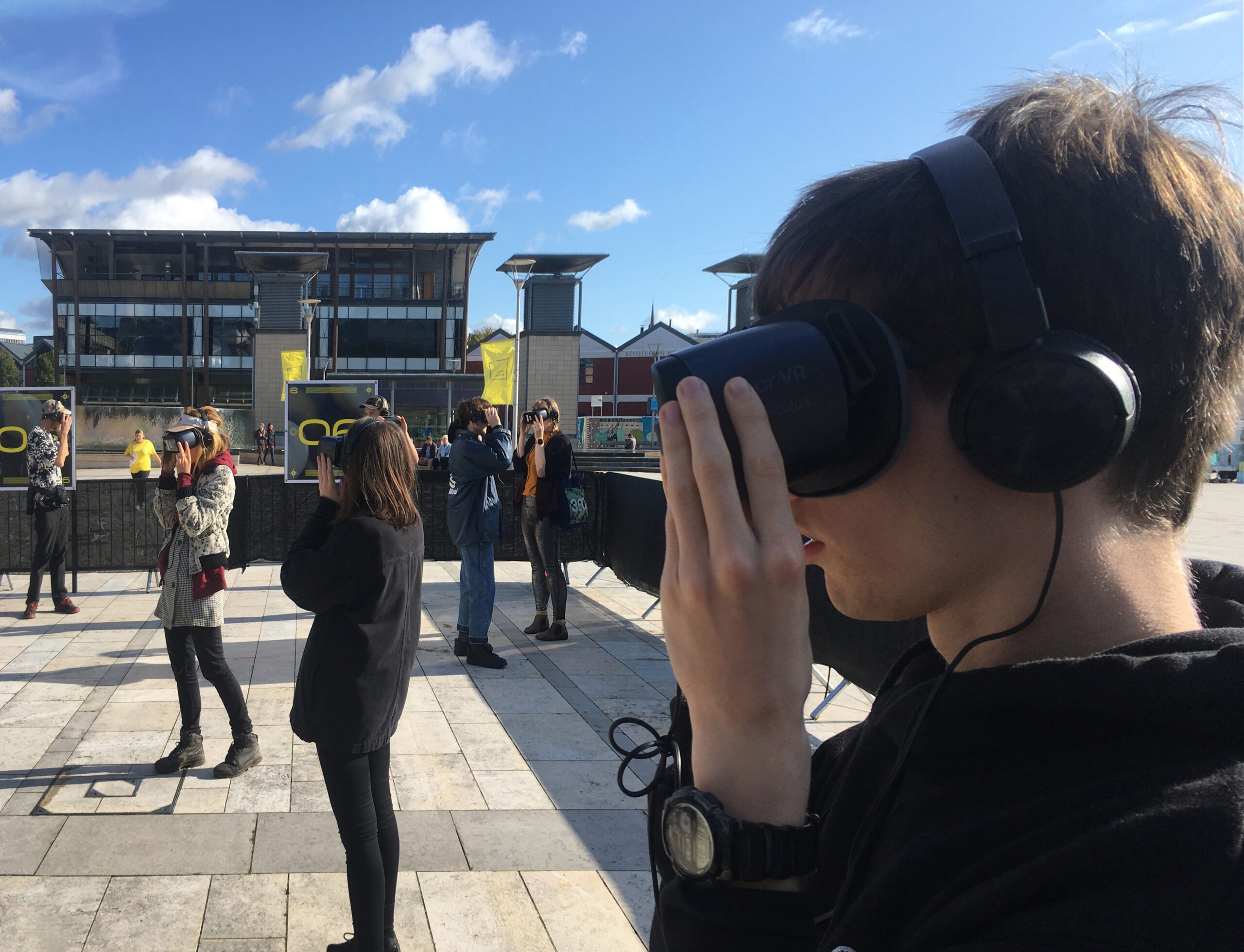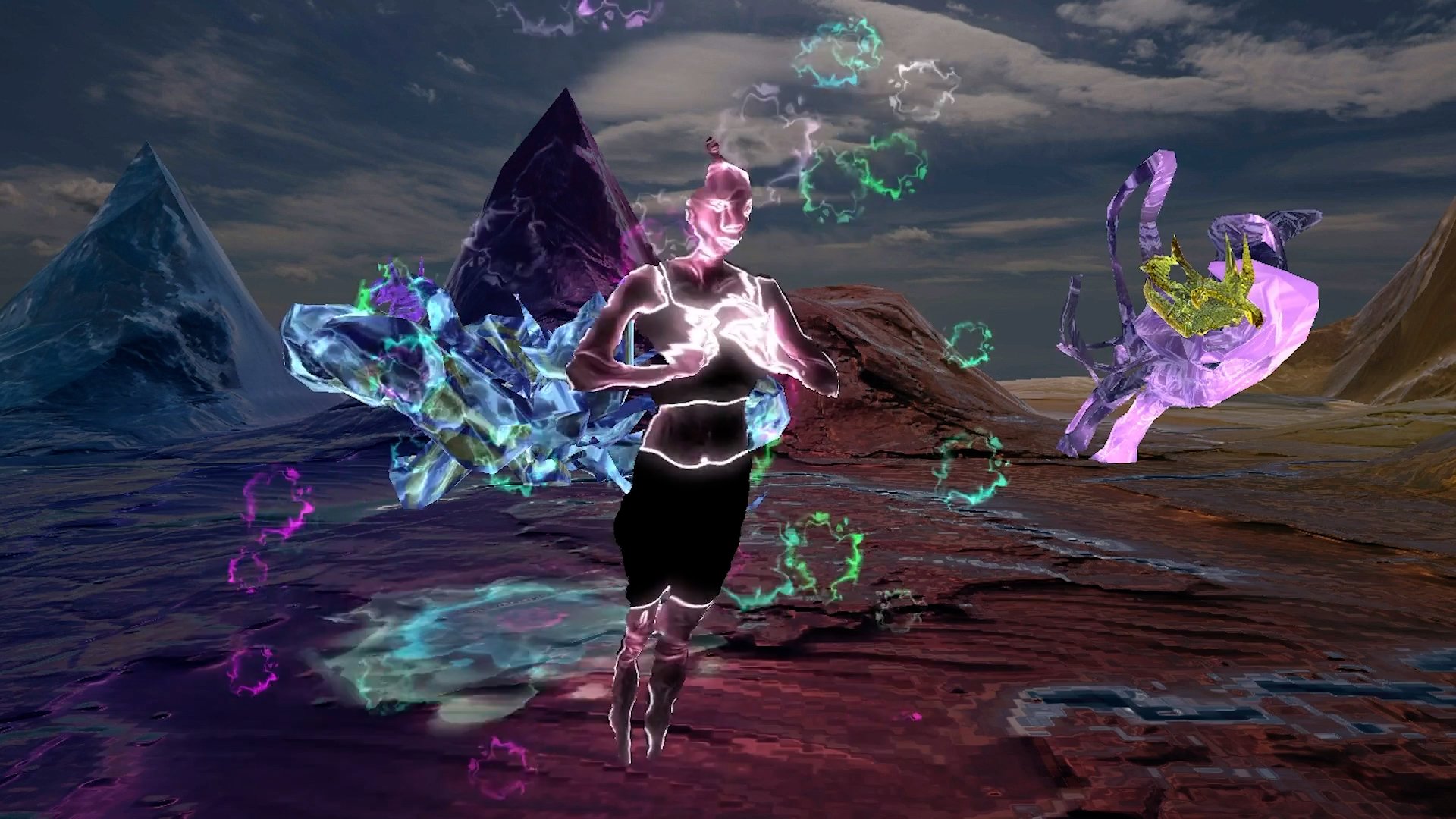Travel beyond the body on a virtual sonic voyage
Aïsha Devi's spatial VR experience
At Bristol’s Simple Things Festival, we unveiled I Am Not Always Where My Body Is – a multi-user 5G-powered VR experience featuring a holographic performance by electronic artist, Aïsha Devi. This immersive piece redefines the boundaries of live performance, inviting festival-goers into an otherworldly audiovisual dreamscape.
Having directed a volumetric video capture session of Aïsha, we transformed her performance into a holographic rendering as the centrepiece of the experience. Set in Millennium Square, groups of 15 participants at a time donned 5G-enabled VR headsets and embarked on a collective, real-time musical journey, synchronizing sound, visuals, and motion into a deeply sensory experience. The installation proved to be an overwhelming success, drawing over 150 attendees in a single day.
Partners
In 2019, we collaborated with Simple Things Festival – organised by our previous collaborators Crack Magazine, Team Love and festival founder Matt Aitken. Taking part in the music festival’s tech showcase, Zubr collaborated with electronic artist, Aïsha Devi to bring her track ‘I’m Not Always Where My Body Is’ to life in an ambisonic virtual reality music video.
Nestled amongst otherworldly visuals supplied by Pussykrew, the virtual experience was brought to life with help from our collaborators at the University of Bristol’s Smart Internet Lab, who supplied 5G-enabled smartphones, in order to use Bristol’s then-pioneering 5G testbed.
The testbed offers dynamic end-to-end slicing and orchestration over heterogeneous wired and wireless networks, enabling the testing of novel applications, like the one enabling Aïsha Devi's hologram."
Professor Dimitra Simeonidou, Academic Lead, University of Bristol Smart Internet Lab
Understandably chuffed about getting a rare interview with one of the most elusive electronic musicians on the planet in the bag, the Crack team have decided to go whole hog on this one, working with both Weirdcore (who designed it) and Bristol studio Zubr (who built it) on an augmented reality app which promises to bring the magazine cover to life.”
Josh Baines, It’s Nice That
Reimagining Devi's performance as a digital entity
To bring this vision to life, Zubr directed a volumetric capture session at Band Studios in Bristol, where Aïsha Devi performed a series of improvised kinetic movements to her track ‘I’m Not Always Where My Body Is’. Using depth-sensing cameras, we transformed her into a glowing holographic form, and processed in 3D renders, stylised into glowing forms to match Pussykrew’s visual aesthetic. These captures were embedded into the virtual environment, seamlessly integrated into the VR space. Our volumetric filming techniques ensured Devi’s performance retained its raw energy, allowing her movements to feel both ethereal and deeply connected to the music.
With the need for a strong focus on musical quality, we called upon our experience building VR spatial audio content using Google’s powerful Resonance Audio technology. We scattered 10 separate stems from Aïsha Devi’s track across our virtual stage, to create a surreal audiovisual soundscape which reacts and evolves as you move through it, allowing participants to discover and shape their own unique, multisensory ‘mix’ of the performance. The vocal tracks were attached to Aïsha’s holographic presence, moving with her as she jumped around the virtual stage, whilst bass and percussion were enhanced visually with explosive particle systems and effects.
A collective VR ritual with freedom to explore
At the heart of the experience was Zubr’s multi-user networking system, which enabled up to fifteen festival-goers to share an intimate, socially connected digital performance – previously seen in our installations at the Limina VR Theatre and the Eden Project. This wasn’t a passive 360° video, but a fully-immersive, free-roaming VR ritual that fused virtual and augmented reality technologies.
Participants were invited into a ten metre square VR zone in Millennium Square, where they could physically move and interact in real time, echoing the fluid, exploratory nature of Aïsha’s music. Each participant took on a virtual alter-ego, represented as a 3D animal skull avatar, heightening the spiritual, transcendent themes of Aïsha’s work whilst reinforcing the idea of identity and presence beyond the physical body.
Delivering this kind of live, multi-user VR experience in a public space demanded cutting-edge technology. In partnership with the University of Bristol’s Smart Internet Lab, we leveraged Bristol’s pioneering 5G testbed – the world’s first 5G urban network. Using 5G-enabled smartphones, we achieved ultra-low latency and a seamless, uninterrupted connection, ensuring the performance remained fluid and immersive from start to finish.
Redefining the future of music and virtual performance
Following the success of the Aïsha Devi VR experience at Simple Things Festival, Zubr continued working with Bristol University to refine the piece for their showcase. I Am Not Always Where My Body Is was a bold step into the future of music, performance, and digital presence, highlighting Zubr’s ambitions when it comes to creative tech. By seamlessly blending volumetric video, spatial audio, and interactive VR, we crafted an immersive experience that transcended traditional music videos and live gigs.
As artists continue to push the limits of performance, we remain committed to exploring new ways of merging music, technology, and immersive storytelling, paving the way for the next generation of digital artistry. To explore more of our XR work within the music industry, our AR experience for Aphex Twin provides insight into Zubr’s technical creativity.








